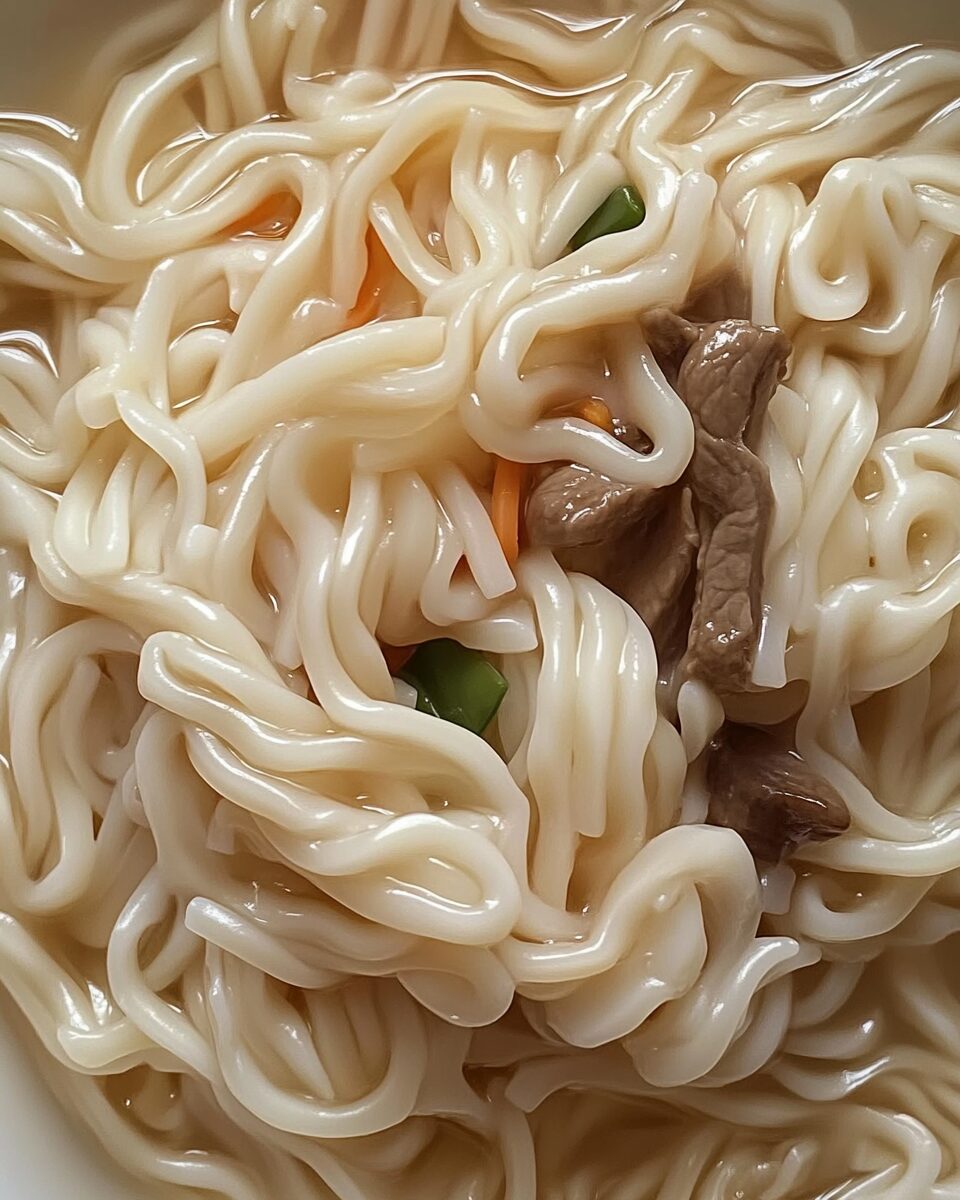Lo Mein Noodles is a classic Chinese dish that’s quick, easy, and full of flavor. This dish features soft noodles, stir-fried with a variety of fresh vegetables and your choice of protein, all brought together by a savory and slightly sweet sauce. The versatility of Lo Mein makes it perfect for any occasion – whether you’re preparing a weeknight dinner or serving it as part of a larger spread. With its perfect balance of textures and flavors, this dish is sure to please everyone at the table.
Full Recipe:
Ingredients
- 8 ounces lo mein noodles (or spaghetti)
- 2 tablespoons vegetable oil
- 1/2 cup sliced onion
- 1/2 cup sliced bell pepper
- 1/2 cup sliced carrots
- 1/2 cup snow peas
- 2 cloves garlic, minced
- 1/4 cup soy sauce
- 2 tablespoons oyster sauce
- 1 tablespoon hoisin sauce
- 1 tablespoon sugar
- 1 teaspoon sesame oil
- 1/2 teaspoon ground black pepper
- 1 cup cooked chicken, beef, shrimp, or tofu (optional)
Directions
- Cook the lo mein noodles according to the package directions, then drain and set aside.
- Heat the vegetable oil in a large skillet or wok over medium-high heat. Add the sliced onion, bell pepper, carrots, and snow peas. Stir-fry for 3-4 minutes until the vegetables are tender-crisp.
- Add the minced garlic and stir-fry for another minute until fragrant.
- In a small bowl, whisk together the soy sauce, oyster sauce, hoisin sauce, sugar, sesame oil, and black pepper.
- Add the cooked noodles to the skillet and pour the sauce mixture over the top. Toss the noodles and vegetables to coat evenly in the sauce.
- If desired, add the cooked chicken, beef, shrimp, or tofu to the noodles and toss to combine.
- Serve the Lo Mein Noodles immediately, garnished with green onions or sesame seeds if desired.
Nutrients
- Calories: 350
- Fat: 10g
- Carbs: 50g
- Fiber: 3g
- Sugar: 9g
- Protein: 15g
- Sodium: 900mg
The History and Origins of Lo Mein
Lo Mein, meaning “stirred noodles,” is a dish with deep roots in Chinese cuisine. The origins of Lo Mein can be traced back to the southern provinces of China, particularly Canton and Shanghai, where stir-frying was perfected as a cooking technique. The name “Lo Mein” comes from the traditional method of stir-frying boiled noodles with vegetables and meat or tofu, creating a deliciously balanced dish that has been enjoyed for centuries.
In its earliest form, Lo Mein was a humble, inexpensive meal that was prepared with leftover ingredients, making it a go-to dish for families. As the dish gained popularity in China and later spread to other parts of the world, variations began to appear, with different regions adding their own twists based on available ingredients. In the U.S., Lo Mein has evolved into a popular Chinese-American dish, often served with thick, rich sauces and paired with a variety of meats or vegetables.
Although the dish’s origins are firmly rooted in Chinese cuisine, it has become a staple of Chinese takeout around the world, especially in Western countries. In fact, Lo Mein has become synonymous with Chinese-American food, often served alongside favorites like General Tso’s chicken, sweet and sour pork, or egg rolls.
The Key Ingredients of Lo Mein Noodles
At its core, Lo Mein is a noodle dish, and the type of noodles used can make a significant difference in the final result. Traditional Lo Mein noodles are made from wheat flour and eggs, resulting in a slightly chewy texture that holds up well to stir-frying. The noodles are typically boiled before being tossed in a savory sauce and stir-fried with vegetables and protein. The texture of the noodles is one of the defining features of Lo Mein, and using the right type of noodle is essential for getting the dish just right.
The sauce that coats the noodles in Lo Mein is another important component of the dish. A well-balanced sauce adds richness and flavor, and the combination of soy sauce, oyster sauce, hoisin sauce, and sugar creates a perfect balance of salty, sweet, and umami flavors. Soy sauce is a key ingredient in the sauce, providing that signature salty and umami flavor that defines many Asian dishes. Oyster sauce, which is made from oyster extracts, brings a rich, savory depth to the sauce, while hoisin sauce adds sweetness and a touch of spiciness. A little sugar helps to round out the flavors, making the sauce smooth and well-balanced.
Lo Mein is also a great dish to customize based on your personal preferences. Vegetables such as bell peppers, carrots, onions, and snow peas are common additions, but you can experiment with other vegetables like mushrooms, zucchini, or bok choy. Protein is another customizable element; while traditional Lo Mein might be made with chicken, beef, or shrimp, the dish can easily be made vegetarian by using tofu or additional vegetables.
Health Benefits of Lo Mein Noodles
Lo Mein is often seen as a comforting, indulgent dish, but it can also provide several health benefits depending on the ingredients used. One of the main components of Lo Mein is the vegetables that are stir-fried with the noodles. Vegetables like bell peppers, carrots, and snow peas provide essential vitamins, fiber, and antioxidants that promote overall health. The fiber in vegetables helps with digestion, promotes a healthy gut, and can help regulate blood sugar levels. Additionally, many vegetables are low in calories, making Lo Mein a relatively low-calorie meal when prepared with plenty of vegetables.
The protein used in Lo Mein can also contribute to a balanced meal. If you choose lean protein options such as chicken breast, shrimp, or tofu, you can make Lo Mein a high-protein dish that supports muscle repair and overall body function. Tofu, in particular, is a great plant-based protein that is rich in essential amino acids and offers a good source of iron and calcium, especially for those following a vegetarian or vegan diet.
While Lo Mein can be a healthy dish, it’s important to keep portion sizes in mind, as the dish can also be high in sodium due to the use of soy sauce and oyster sauce. However, by choosing low-sodium soy sauce or adjusting the amount of sauce used, you can make a healthier version of Lo Mein without sacrificing flavor. Additionally, using whole wheat noodles or adding more vegetables to the dish can increase the fiber content and make it a more nutrient-dense meal.
Making Lo Mein Noodles: A Quick and Easy Recipe
One of the best aspects of Lo Mein is how easy it is to prepare. Unlike many complex dishes, Lo Mein comes together quickly, making it an ideal choice for busy weeknights or for anyone who wants to enjoy a flavorful meal without spending hours in the kitchen. The key is to have all the ingredients prepped and ready to go before you begin cooking, as stir-frying requires quick, high-heat cooking.
Start by boiling the noodles until they are tender but still firm enough to hold their shape when stir-fried. It’s important not to overcook the noodles at this stage, as they will continue to cook when tossed in the sauce. After cooking the noodles, drain them and set them aside while you stir-fry the vegetables and protein.
Once the vegetables and protein are stir-fried in oil, it’s time to add the cooked noodles and sauce. Toss everything together until the noodles are evenly coated in the savory sauce, and allow the dish to cook for an additional few minutes, allowing the flavors to meld. The beauty of Lo Mein lies in its simplicity, making it the perfect dish for beginner cooks or anyone looking for a quick, satisfying meal.
Lo Mein Noodles: A Versatile Dish for All Occasions
Lo Mein Noodles are incredibly versatile and can be adapted for any occasion. Whether you’re serving it as a simple weeknight dinner or making it for a larger gathering, Lo Mein offers endless customization options to suit your tastes. You can easily adjust the sauce to make it spicier or sweeter, depending on your preferences. You can also change up the vegetables or protein to create a dish that fits your dietary needs.
Lo Mein is also a great dish for meal prepping, as it stores well in the refrigerator and can be reheated for lunch the next day. If you’re making it for a party or large gathering, you can easily double the recipe to serve a crowd. Because the dish is so customizable, it’s a great option for anyone who enjoys experimenting with new flavors and ingredients.
Conclusion: Why You Should Try Lo Mein Noodles
Lo Mein Noodles is a flavorful, easy-to-make dish that has earned a permanent spot in kitchens around the world. Its combination of soft, chewy noodles, tender vegetables, and savory sauce makes it a comforting and satisfying meal that appeals to a wide range of tastes.

